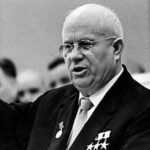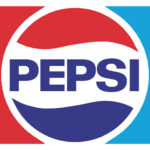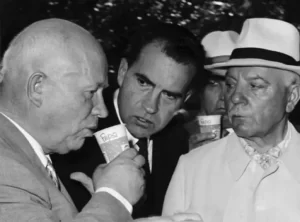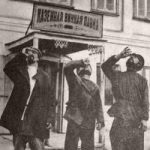vodka

 In 1959, President Dwight Eisenhower wanted to convince the Soviet Union that capitalism could greatly benefit the country. If accepted, the Soviet Union would for all intents and purposes become “Americanized” and would probably have been better off. Of course, not everyone agreed with that idea. Nevertheless, Eisenhower, in an effort intended to showcase their ideologies, arranged the “American National Exhibition” in Moscow. To head up the project, they sent Vice President Richard Nixon to attend the opening. What started out as a potentially good idea, quickly took a turn for the worse when Nixon and Soviet leader Khrushchev got into an argument over the topic of capitalism versus communism. Trying to prove someone wrong in their belief system is no easy task, and the conversation quickly got so heated that the vice president of Pepsi intervened and offered the Soviet leader a cup of his delicious, sugary beverage…which he drank…and very much liked.
In 1959, President Dwight Eisenhower wanted to convince the Soviet Union that capitalism could greatly benefit the country. If accepted, the Soviet Union would for all intents and purposes become “Americanized” and would probably have been better off. Of course, not everyone agreed with that idea. Nevertheless, Eisenhower, in an effort intended to showcase their ideologies, arranged the “American National Exhibition” in Moscow. To head up the project, they sent Vice President Richard Nixon to attend the opening. What started out as a potentially good idea, quickly took a turn for the worse when Nixon and Soviet leader Khrushchev got into an argument over the topic of capitalism versus communism. Trying to prove someone wrong in their belief system is no easy task, and the conversation quickly got so heated that the vice president of Pepsi intervened and offered the Soviet leader a cup of his delicious, sugary beverage…which he drank…and very much liked.
Most people who try sodas, like them, and most have a favorite soda that they enjoy whenever they get the opportunity. For Khrushchev and the people of the Soviet Union, this drink was very different from anything they had tasted before, and they were quickly hooked. Years later, the people of the Soviet Union wanted to strike a deal that would bring Pepsi products to their country permanently. The biggest problem, when it came to importing Pepsi to the Soviet Union, was that Soviet money was not accepted throughout the world. They would have to find something they could trade if they wanted to make this deal. So, they cleverly decided to buy Pepsi using a universal currency…vodka!
In the late 1980s, as their initial agreement to serve Pepsi in their country was about to expire, Russia wanted to renew the deal. Unfortunately for them, this time, their vodka wasn’t going to be enough to cover the cost. The question became…what now? They now had to decide just exactly how much they were willing to pay for the addiction that Pepsi really is. In a wild deal, and one that would seem insane to most of us, Russia decided that it was worth giving up a military arsenal big enough to stock a whole country. So, in order to make the 
 deal, the Russians traded Pepsi a fleet of subs and boats for a whole lot of soda. The new agreement included 17 submarines, a cruiser, a frigate, and a destroyer. Now, that is a whole lot of Pepsi’s worth. In fact, it was three billion dollars’ worth of Pepsi. So, with this historical exchange, Pepsi to become the 6th most powerful military in the world…for a moment anyway. Then, they sold the fleet to a Swedish company for scrap recycling, ending the short-lived military strength of Pepsi. To this day, some people call this a rumor.
deal, the Russians traded Pepsi a fleet of subs and boats for a whole lot of soda. The new agreement included 17 submarines, a cruiser, a frigate, and a destroyer. Now, that is a whole lot of Pepsi’s worth. In fact, it was three billion dollars’ worth of Pepsi. So, with this historical exchange, Pepsi to become the 6th most powerful military in the world…for a moment anyway. Then, they sold the fleet to a Swedish company for scrap recycling, ending the short-lived military strength of Pepsi. To this day, some people call this a rumor.
 Our enemies really depend on the war we are in. In World War II, Russia was on the side of the United States. While they might not have really been our ally, they weren’t really our enemy either, so I guess they were our “frienemy.” In reality, they were in just as much danger as any other member of the Allies. Germany had made a deal with them, but then invaded them anyway. World War II was a fear-filled time. It was a hard-fought war, against terrible enemies. There were times that it looked like Hitler would win, but in the end, he did not, and as far as history knows, he committed suicide, along with his wife, Eve Braun Hitler, who married him the day before.
Our enemies really depend on the war we are in. In World War II, Russia was on the side of the United States. While they might not have really been our ally, they weren’t really our enemy either, so I guess they were our “frienemy.” In reality, they were in just as much danger as any other member of the Allies. Germany had made a deal with them, but then invaded them anyway. World War II was a fear-filled time. It was a hard-fought war, against terrible enemies. There were times that it looked like Hitler would win, but in the end, he did not, and as far as history knows, he committed suicide, along with his wife, Eve Braun Hitler, who married him the day before.
The people of the Soviet Union heard on the radio on May 9, 1945, at 1:10am, that Nazi Germany had signed the act of unconditional surrender. That surrender ended the USSR’s fight on the Eastern Front of World War II, or the Great Patriotic War as the Soviets called it. That war had been devastating consequences…according to official data, the state lost more than 26 million people. It was a great day for Russia and for the world. Hitler was dead, and the world could move forward and begin to heal. It was truly a rare case of an indestructible victory over its worst enemy, and the people of the state began a traditional method of celebration…drinking vodka and toasting to their victory.
The party began that day, May 9, 1945, and continued without ceasing for about 22 hours. People were so excitedly celebrating that they really didn’t think about their condition. They went outside in their pajamas,  embraced, and wept with happiness. They didn’t care if they were in their pajamas, they were elated, and they partied. In fact, even non-drinkers began to drink. The party came to a screeching halt 22 hours later when the wartime deficiency of vodka, led to a unique situation. The party was in full swing, and when Joseph Stalin stepped up to address the nation in honor of the victory, the population had drunk all the vodka reserves in the country. I don’t think people really cared at that point what they toasted with. They would gladly lift a glass of water to cheer the victory. Nevertheless, how often does an entire nation run out of liquor…unless the nation is in prohibition, that is?
embraced, and wept with happiness. They didn’t care if they were in their pajamas, they were elated, and they partied. In fact, even non-drinkers began to drink. The party came to a screeching halt 22 hours later when the wartime deficiency of vodka, led to a unique situation. The party was in full swing, and when Joseph Stalin stepped up to address the nation in honor of the victory, the population had drunk all the vodka reserves in the country. I don’t think people really cared at that point what they toasted with. They would gladly lift a glass of water to cheer the victory. Nevertheless, how often does an entire nation run out of liquor…unless the nation is in prohibition, that is?

